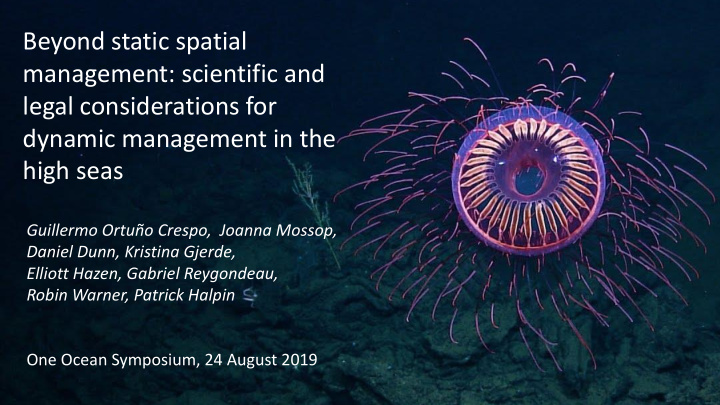



Beyond static spatial management: scientific and legal considerations for dynamic management in the high seas Guillermo Ortuño Crespo, Joanna Mossop, Daniel Dunn, Kristina Gjerde, Elliott Hazen, Gabriel Reygondeau, Robin Warner, Patrick Halpin One Ocean Symposium, 24 August 2019
Overview • The oceanography of the high seas changes across a wide range of temporal scales. • Outline of temporal scales that may be relevant to ABMTs • Ephemeral • Intra-annual • Inter-annual • Multi-decadal • Suggestions for text to ensure the BBNJ ILBI is future-proof.
Sig ignif ificant advancements and opportunities sin ince UNCLOS • The processes at each temporal scale have unique impacts on the distribution, abundance, composition and size of BBNJ. • Technological and computational advancements allow us to map, monitor and predict the distribution of humans and BBNJ in near-real time and into the future. • Opportunities for capacity development, increase efficiency of industry and reduce BBNJ impacts.
Ephemeral: technological advancements allow for monitoring Dynamic Ocean Management Advances in geospatial technologies (e.g. satellite imagery or Howell et al., 2008 AIS tracking technology) allow for near-real time monitoring and modelling of BBNJ and H(umans)BNJ.
Intra-annual: reliable & predictable - Seasonal / predictable changes in oceanographic conditions or persistent features may allow for efficient intra-annual closures or rules to fishing and shipping to reduce impacts on BBNJ. Dunn et al, Policy Brief: Deep, Distant and Dynamic 2017
Inter-annual: semi-predictable – ‘shocks’ to BBNJ • Inter-annual climatic cycles change the El Niño Southern Oscillation biology, physics and chemistry of the high seas in semi-predictable ways. • If unaccounted for shift in climatic indices may deem intra-annual closures ‘useless’ . • Large-scale ocean die-offs & redistribution of resources and BBNJ is well documented. • Serious implications for industry. BBNJ can increase knowledge and work with sectoral organizations.
Multidecadal: preparing for future oceans • We expect changes in the… [1] abundance; [2] vertical & horizontal distribution; [3] phenology (‘biological clock’); [4] size; [5] behavior; [6] extinction risk; [7] predator-prey relationships; … of BBNJ under climate change.
Textual Recommendations: Art 1 “… a tool for a defined area, through which one or several sectors or activities are managed across temporal or spatial scales with the aim of achieving particular conservation and sustainable use objectives”
Proposals for ABMTs: Article 17 (4) Proposals shall contain the following elements: (a) A description of the area that is the subject of the proposal based on geographic or other characteristics … (f) A description of the proposed conservation and management measures to be adopted to achieve the specified objectives Query whether additional provision is needed: (bis) Delineation of zones within the proposed area, if relevant, and any specific management measures to be adopted within each of those zones
Monitoring and Review: Art 21 4. Following the review the COP shall, as necessary, take decisions on the revision of ABMTs, including MPAs, including any associated conservation and management measures, on the basis of an adaptive management approach and taking into account the best available scientific information including traditional knowledge, the precautionary approach, the ecosystem approach, and the goal that any revision should achieve the original objective of the ABMT as much as practicable. [Alt 2] …The duration of MPAs and related conservation and management measures shall be specified. These areas and related measures shall terminate automatically upon the expiration of the time period, unless otherwise decided by the same body that decided on the initial establishment.
Thank you!
uncertainty and scenarios Multidecadal change – Multi-annual cyclical or partially cyclical shocks Predictable seasonal patterns of productivity and consumption U.S. recession time series (‘shocks’ to the system) ENSO cycle (‘shocks’ to the system) Dynamic features affect short-term distribution and behavior Temporal scales of relevance Homo sapiens High seas oceanography Just like human beings, biodiversity in the high seas respond to processes across a wide range of temporal scales
uncertainty and scenarios Multidecadal change – Global human population trends Multi-annual cyclical or partially cyclical shocks Predictable seasonal patterns of U.S. recession time series (‘shocks’ to the system) ENSO cycle (‘shocks’ to the system) productivity and consumption Monthly change in chlorophyll productivity Dynamic features affect short-term distribution and behavior Dynamic changes in distribution and behavior High seas oceanography Temporal scales of relevance Homo sapiens
Recommend
More recommend